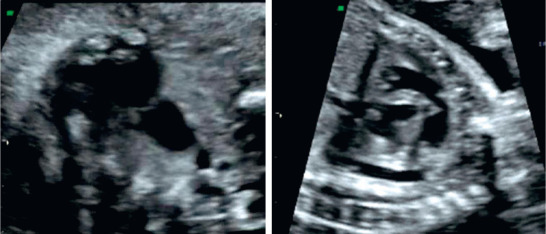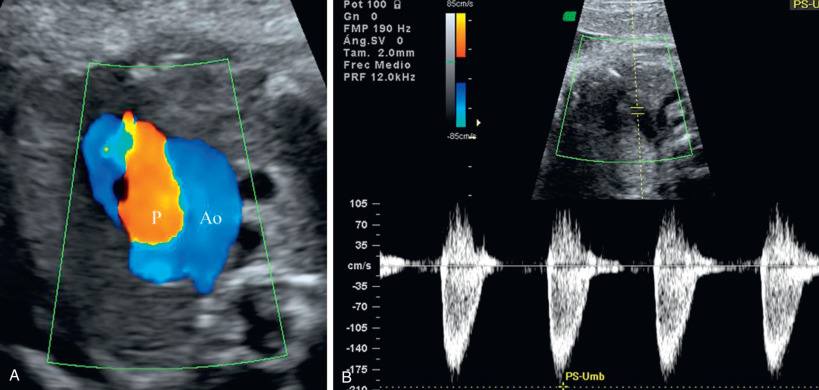Abstract
Pulmonary stenosis (PS) and pulmonary atresia (PA) are congenital heart defects affecting the pulmonary valve with a low incidence in the fetus. The diagnosis is made on the four-chamber view. In most severe cases, there is significant tricuspid insufficiency with variable degrees of cardiomegaly. If the tricuspid valve is also atretic, the right ventricle is hypoplastic. In mild forms of PS, the diagnosis is possible only in the right ventricular outflow tract view. Association with extracardiac and chromosomal abnormalities is low (<2%). However, PS and PA in the presence of a ventricular septal defect are frequently associated with other cardiac malformations (especially conotruncal anomalies). Fetal karyotyping and careful examination of the cardiac and extracardiac anatomy should be considered. A follow-up examination every 2 to 4 weeks is recommended to assess the development of the tricuspid valve, the right ventricle, and the pulmonary artery. The obstetric management should not be changed in the absence of hydrops. Mild forms of PS have an excellent prognosis. In critical PS and PA, the suitability for biventricular or univentricular repair determines the prognosis.
Keywords
pulmonary valve, stenosis, atresia, right heart
Introduction
Pulmonary stenosis (PS) and pulmonary atresia (PA) with intact ventricular septum have a low incidence in the fetus. In PS, there is a narrowing of the right ventricular outflow tract, whereas PA is characterized by an absent ventriculoarterial connection. The conditions are anatomically related, but the prognosis may vary substantially.
Disease
Definition
PS refers to a narrowing of the right ventricular outflow tract secondary to a lesion that can occur at any of three levels—valvular, subvalvular, or infundibular region of the pulmonary artery. The most common form is a dysplastic valve with partial fusion of the three pulmonary valve cusps.
PA with intact interventricular septum, also known as hypoplastic right heart syndrome, is characterized by complete blockage of the right ventricular outflow tract. Atresia usually occurs at the level of the valve, and less frequently the pulmonary artery is also atretic. The competence of the tricuspid valve and the presence of tricuspid anomalies determine the development of the right ventricle, but this is usually hypoplastic with a proportionally smaller tricuspid valve. Less commonly, the right ventricle is dilated or of normal size.
Prevalence and Epidemiology
The estimated incidence of PS is approximately 9% to 10% of all congenital heart diseases (CHDs) diagnosed in neonates. PA is diagnosed in 1 : 22,000 live births, and it accounts for 1% to 5% of all prenatally diagnosed CHDs.
Etiology and Pathophysiology
As in most CHDs, the etiologies of PS and PA are multifactorial. The risk of chromosomal anomalies and extracardiac malformations is low; there is a 2% risk of aneuploidy. PS can appear in the context of different nonchromosomal syndromes (e.g., Williams, Alagille, and Noonan syndromes), and it is a typical finding of congenital rubella syndrome.
As with any other CHD, PS can be associated with other CHDs:
- 1.
Isolated PS is less commonly diagnosed in fetal life because the diagnosis is more challenging, especially in less severe forms.
- 2.
PS associated with other CHDs, typically with conotruncal anomalies, represents the most common form detected during fetal life.
- 1.
PA type I (75% of cases): there is a competent or atretic tricuspid valve, and the right ventricle is hypoplastic. This form is associated with the presence of ventriculo-coronary arterial fistulas in 30% of cases.
- 2.
PA type II (25% of cases): the tricuspid valve is incompetent or insufficient and there is a normal or, more frequently, a dilated right ventricle. This form of PA can be associated with anomalies of the tricuspid valve (e.g., Ebstein anomaly or tricuspid dysplasia; see Chapter 80 ).
Manifestations of Disease
Clinical Presentation
Mild forms of PS are well tolerated during fetal life, and newborns may remain initially asymptomatic. In critical PS and in PA, there is a significant risk of heart failure and cyanosis. Prostaglandin E 1 infusion in the early neonatal period is mandatory to prevent closure of the ductus arteriosus until surgery is scheduled. Neonatal management and prognosis is worse in the presence of right ventricle-dependent coronary circulation (30% of cases with PA type I) and if there is a dilated and noncontractile right ventricle (PA type II).
Imaging Technique and Findings
Ultrasound
Pulmonary Stenosis.
The possibility of prenatal ultrasound diagnosis depends on the degree of obstruction of the pulmonary artery.
- •
Moderate obstruction (mild PS): the four-chamber view may be normal, and PS can be detectable only if the right ventricular outflow tract is evaluated, especially when applying color Doppler.
- •
Severe obstruction (severe or critical PS): the diagnosis can be suspected on the four-chamber view because this form is usually associated with different degrees of right ventricular hypertrophy and tricuspid insufficiency.
- •
signs of dysplasia of the pulmonary valve, including increased echogenicity, thickening, and hypomobility ( Fig. 79.1 )

Fig. 79.1
Pulmonary stenosis in a short- and long-axis view of the right ventricle. The diameter of the pulmonary valve is decreased, the valve is thickened, and there is a poststenotic dilatation.
- •
diameter of the pulmonary valve and artery smaller than expected for gestational age (ratio pulmonary to aorta <1) (see Fig. 79.1 )
- •
poststenotic pulmonary artery dilatation, occurring as a consequence of the systolic accelerated jet (see Fig. 79.1 )
- •
color Doppler showing turbulent systolic flow (with aliasing) ( Fig. 79.2 ); pulsed wave Doppler confirms the presence of this high accelerated flow, with maximum velocities during systole greater than 140–200 cm/sg ( Fig. 79.3 )











